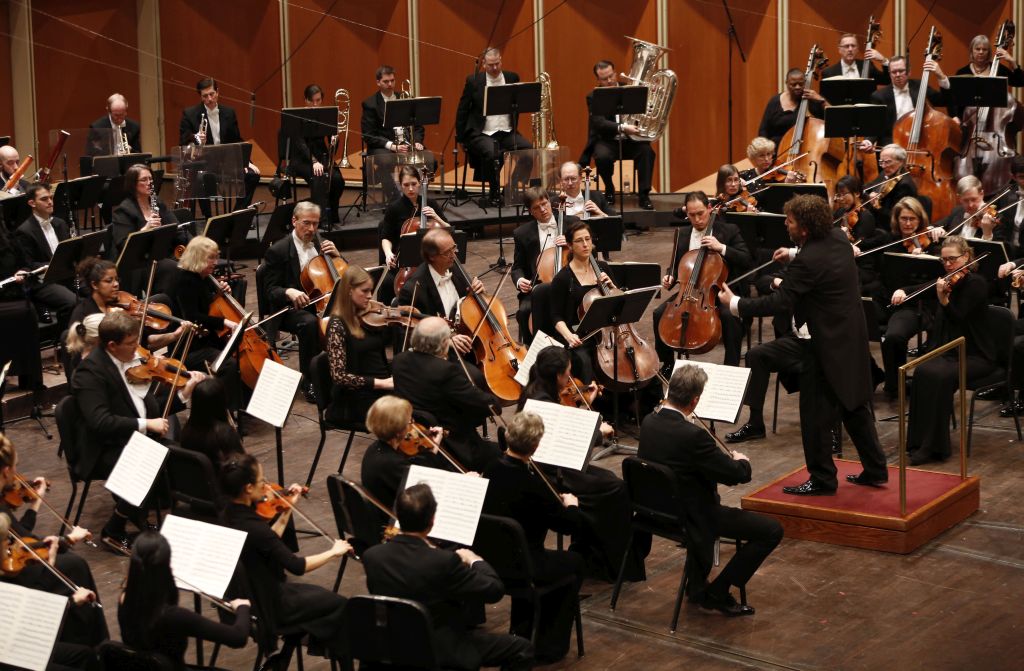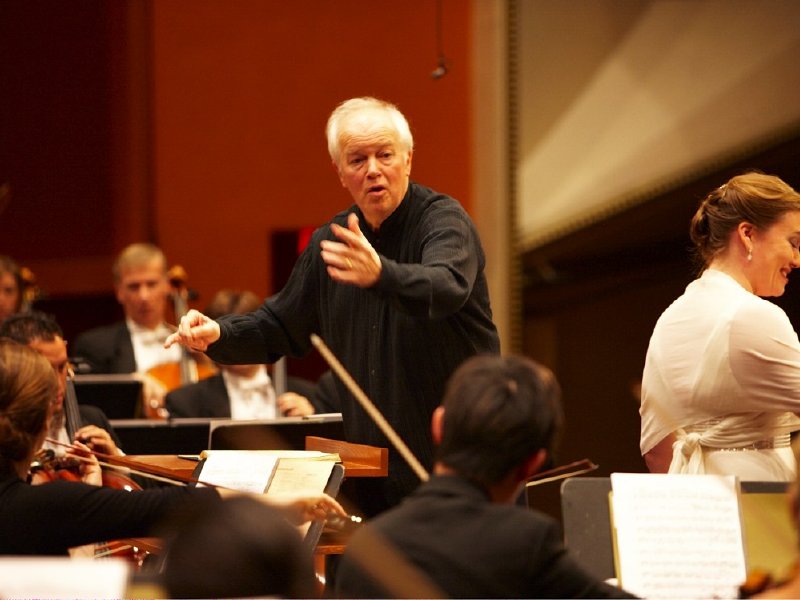Who Will Be the Next MSO Music Director?
Symphony search committee may lean toward an American. Beyond that, it depends.
In the last two seasons, audience members at the Milwaukee Symphony Orchestra have seen and heard 20 guest conductors. Potentially, one of these will be named the new music director of the MSO, replacing Edo de Waart whose contract expired in Spring of 2017.
Since its inception in 1959, the orchestra has had only six music directors. Although audience favorites such as Beethoven symphonies will likely remain a staple of the repertoire, the seventh director faces the challenges of bringing the orchestra to a Milwaukee community that has changed dramatically in the twenty-first century.
Regular symphony concertgoers know that the search is active. However, the complex process behind the search may be a mystery. How does an orchestra select its next music director?
Douglas Hagerman, chair of the music director search committee and board chair of the League of American Orchestras, explains: “We have a committee with nine members — four board members, four musicians, and Mark.” Mark, of course, is MSO executive director Mark Niehaus.
“We started with the mission and how the music director position relates to the mission,” says Hagerman. “We don’t have an official shortlist, but do have some people that we’re particularly looking at. People go on and off that list over time.”
The mission of the orchestra is, in brief, “to comfort, educate, entertain and exhilarate the human soul through events of cultural significance, relevance and artistic challenge; to embrace, preserve and foster our musical heritage; and to enhance the vibrancy of our community.”
It’s not unusual for over 150 applicants to be screened for conducting positions, among them American and international candidates. Niehaus and Hagerman have visited candidates in other cities. They acknowledge that the grapevine plays a role as well.
In addition to conducting the orchestra, the candidates have met with the staff and the board. Musicians and audience members have been invited to evaluate the conductor as well. After each performance, musicians are issued a questionnaire asking them to rate the conductor.
What do the music directors do? Much more than rehearsing and leading performances. They handle personnel issues and hire musicians. For example, de Waart hired close to 40 percent of the current musicians in the MSO. They also develop relationships with donors. And choose repertoire for the season.
Visiting conductors have been asked to suggest music for the concerts they will conduct. This season, each guest conductor needed to program a work by an American composer. Some of the visiting conductors have worked closely with composers to commission new music for orchestra, such as Cristian Măcelaru, who worked with Jake Heggie prior to bringing his Moby-Dick Suite to Milwaukee in September 2017, and Joshua Weilerstein, who has an ongoing musical relationship with the composer Christopher Rouse, whose composition Bump was performed this spring.
“We’ve tried to design concerts that will test conductors’ abilities,” says Hagerman. “You can learn something about a music director when they conduct a new work; you can learn something when they conduct a concerto with a soloist; and when they conduct a big chestnut” with the orchestra.
Practically speaking, as symphonic writing grew over the centuries to incorporate more musicians and even choruses, conductors could no longer direct the players from the piano or harpsichord. Think of the Verdi Requiem, which the MSO performed in May 2016 under the baton of Asher Fisch. The conductor must coordinate a full orchestra, choir, and four soloists. The elevated podium allows the conductor to survey the different sections and communicate musical ideas. There are legendary stories in orchestra circles about the ways that glowering conductors intimidated musicians from the podium (parodied in the Bugs Bunny short “Leopold”).
The dark side of the conductor’s position is that it has the potential to be abused, as recent revelations about James Levine and Charles Dutoit have shown. In a heated call for change published in the New York Times, Zachary Woolfe notes: “The way some conductors have abused their power… is a function of being granted so much power in the first place.”
The iconic figure of the conductor as deity is the product of the mid- to late-nineteenth century. Hans von Bülow, the eccentric and demanding conductor of the Berlin Philharmonic, was the first modern conductor to polish his image as a singular human gifted with the ability to interpret the will of the composer, “a semi-spiritual conduit,” as Woolfe calls it. Von Bülow even wore white kid gloves to conduct.
“Orchestras cultivated an exclusive image,” Niehaus notes. “Wearing the white tie and tails. I have this conversation with candidates.”
Hagerman believes “the concept of an orchestra as it has been must change. There are many things a music director can do to make the community feel welcome. That’s an important element of the search. A music director who makes the orchestra valued for the whole community is going to be better for us in the long run.”
Niehaus adds, “We want someone who is interested in concerts that are something other than a formal event that happens between eight and ten o’clock at night.” And while symphonic music is not to everyone’s taste, he emphasizes that “anyone should feel welcome.”
Rehearsals are a crucial part of the concert experience. It is the time when the conductor builds a relationship with the orchestra. Usually nine to eleven hours of rehearsal precede each MSO subscription performance. Conductors interpret the music, everything from tempo to dynamics. They work on certain passages to bring out the voices of different instruments. They communicate their intentions with few words–and instead with the baton or their hands.
Yannick Nézet-Séguin, current music director of the Philadelphia Orchestra, told the New York Times, “Basically the hands are there to describe a certain space of the sound and to shape that imaginary material.”
Audiences don’t need to be experts in musical analysis to feel like they have a stake in the outcome of the music director search. Both Hagerman and Niehaus point out that watching and listening during a performance can tell the audience many things about the conductor.
“Don’t be fooled by your eyes,” Niehaus cautions. “Ask if what the person is doing on the podium is entertaining or helpful. Those two things get confused. Someone who jumps around a lot and is very energetic physically–is that in service of the music? Is it helping the orchestra play well? Is it helping Beethoven communicate with you? Or is it just fun to watch?”
Close your eyes, he suggests. “Were you swept away for that period of time and brought into the world of that composer’s ear? Chances are the conductor had something to do with that.”
Hagerman is concerned with community engagement. “If they speak from the stage, can you relate to them? More importantly, do you think they’d be able to relate to your neighbor who doesn’t come to concerts?”
Gender and cultural diversity are also a concern for all orchestras, not only the Milwaukee Symphony. The Guardian described orchestra conducting as “one of the last glass ceilings in the music industry.” Of the hundreds of orchestras in the United States, fewer than 15 percent are conducted by women. And of the 20 guest conductors who have performed with the MSO in the past two seasons, only three have been women, a percentage that again hovers at around 15 percent. One, Joann Falletta, was the associate conductor of the MSO from 1985 to 1988; she is now music director of the Buffalo Philharmonic. Karina Canellakis visited Milwaukee twice, both this season and last season.
Some writers, like Norman Lebrecht in The Maestro Myth, attribute the disparity to traditional viewpoints and unspoken demands from musicians and audiences for a male authoritarian on the podium.
Diversity, equity, and inclusion are equally important. Consider the demographics of Milwaukee, in which the minority population is close to 57 percent, making people of color the majority cultural stream in the city.
The 2016 League of American Orchestras conference was devoted to these issues. It has released a diversity statement and positioned diversity at the forefront in the 41-page strategic plan.
In US history, the number of black conductors from the 1930s to the 1970s–the same era when stars like Serge Koussevitzky and Arturo Toscanini were recording with RCA Victor–was so few that they could be counted on one hand: Dean Dixon, Everett Lee, William Grant Still and Henry Lewis. In recent years, active youth musical organizations have opened opportunities for musicians and conductors of color, yet the disparity in numbers remains.
“To be a conductor you have to start very young and the awareness that that is a possibility for black children is not encouraged in schools or in the media,” Canadian conductor Kwamé Ryan told the Guardian. That was in 2004–and the situation hasn’t changed in fourteen years. In “On the Cultural Specificity of Symphony Orchestras,” a post from the think tank Createquity in October 2017, author Ian David Moss, pointed out that “the proportion of African American and Latino musicians in U.S. orchestras is just 4%, a number that has barely budged since 2002.”
Alexander Laing, principal clarinet with the Phoenix Symphony and member of the League of American Orchestras diversity forum, an advocate for inclusive arts, sees the need for a complete rearticulation of the system. He recently told Symphony magazine, “To me, the end game is not just having more black or brown people on stage, though that makes a nice picture and certainly has an impact on audience members and musicians on stage . . . but on its own it won’t change the strategic or artistic direction and priorities of organizations.” Laing advocates programming streams “that would offer the potential for cultural affirmation within this art form to people who aren’t white.”
Hagerman adds that it is essential for the new music director to advocate for the role of music in the community. “We need outreach, we need inclusion, we need people to feel welcome at an MSO concert, and it takes some change to really do that. We’re looking for someone who is open to change.”
In addition, there is a question about Europeans versus Americans as music director. It’s no secret that Hagerman supports hiring an American music director. “The last four music directors have been Europeans. I think it’s important to take a close look at American conductors because there’s a lot of talent out there and American conductors bring a potential ability to relate to the audience because they grew up in a community like Milwaukee.”
The search for a new music director for the symphony is a complex process that involves decisions about the community and communication, as well as a quest for leadership, artistry, relevance, and the intangible synergy that results in a moving orchestral performance. It is clear though, that the new music director of the MSO will need to be up for the challenge–and will also have an incredible opportunity to shape the future of Milwaukee itself.
“This job is set up for success,” says Niehaus.
























I like Weilerstein. I think we could use a young conductor.
Thanks for this article. Very interesting
Karina Canellakis would be a real coup for the MSO and Milwaukee in general.